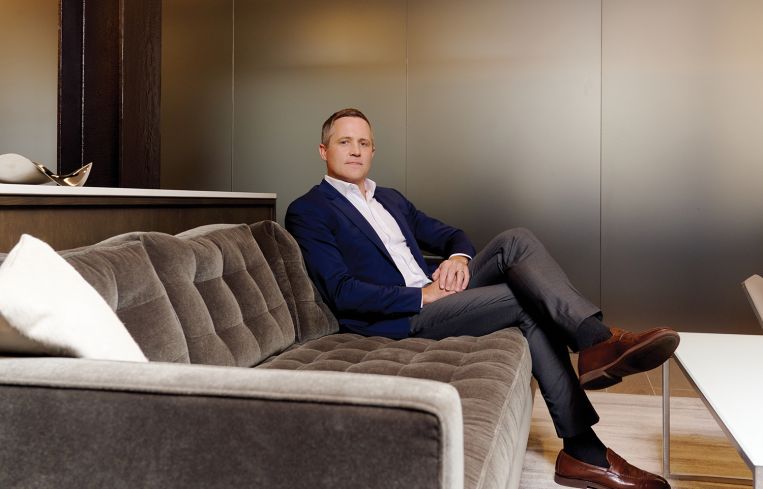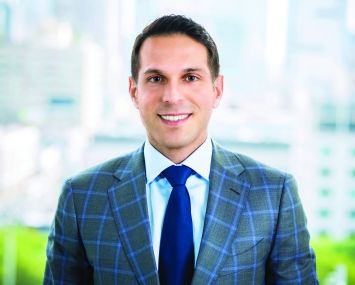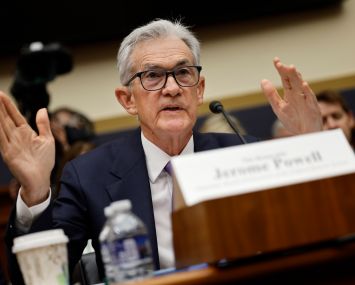King Street Capital’s Mark Van Zandt On Asset Pricing and Credit Spreads
By Andrew Coen May 24, 2023 8:00 am
reprints
Mark Van Zandt’s desire to pursue opportunistic real estate investing brought him to King Street Capital Management in early 2022.
Van Zandt became co-head of real estate at the global alternatives investment firm following a 12-year stint at BentallGreenOak (BGO) where he most recently was portfolio manager for the firm’s U.S. value-add funds. The new position armed Van Zandt with the chance to march into a leadership role scaling King Street’s commercial real estate business as lender and direct owner. Since 2010, the Manhattan–based company has committed over $4 billion of capital across over 60 direct commercial real estate transactions.
Van Zandt’s arrival at King Street in February 2022 came just before market volatility struck CRE as the Federal Reserve started what turned out to be 10 (and counting) consecutive interest rate hikes to fight inflation . Van Zandt is not new to navigating choppy waters. He was a vice president at Morgan Stanley (MS) Real Estate from 2004 to 2010, including during the Global Financial Crisis.
Van Zandt spoke with Commercial Observer at King Street’s Manhattan headquarters about opportunities in a climate where banks are largely on the sidelines of capital for CRE deals, his outlook for New York City, and the advantages of King Street being on the borrowing and lending side of the business.
The interview has been edited for length and clarity.
Commercial Observer: Where did you grow up and what were some of your hobbies as a youngster?
Mark Van Zandt: I grew up in suburban Chicago and, in terms of hobbies, I played hockey, which was my main sport that I played through high school and a little bit in college.
How did your path into the commercial real estate profession take shape?
My dad spent most of his career in commercial real estate. He leased office buildings in suburban Chicago. So that’s how I first got exposed to it, and I was probably one of the few kids in high school who was already dead set on trying to be a real estate developer, which, of course, I didn’t end up doing, but I was exposed to the business early on and interested in it.
When I graduated college, I got into commercial real estate banking and lending in Chicago. It’s where I started my career and did that for a couple of years; and ultimately was then hired by Morgan Stanley, which led me to a long, winding path to where I am now. But I was interested in the business really early on, and I did have an interest as a kid and in architecture and buildings and design, so there is a natural overlap with that.
Prior to joining King Street last year you had more than a decade run at BGO. What led to the decision to take on this new role?
Morgan Stanley Real Estate brought me to New York 15 years ago, which I’m glad they did because not only did it set my career on the path that it’s on but, more importantly, I met my wife. I was supposed to be here for two years and here I am 15 to 16 years later. We had a great business at Morgan Stanley, and I was there through the Global Financial Crisis. The business changed a lot post-GFC, and so I ended up leaving there to join Green Oak Real Estate when we founded that business in 2010.
It was a great run for the 12 years I was there. We built an amazing business and one that I’m quite proud of being a part of. But we sold that business to Sun Life in 2019, which is what created BGO, and that gave me the opportunity to re-evaluate what I want to do with my life. Ultimately I decided that I wanted to focus more exclusively on opportunistic real estate investing, which we had done a lot of early on at Green Oak, but less so in the later years that I was there. I wanted to do it more in a leadership capacity and help grow a business and lead a business, and King Street gave me the opportunity to do that. And I had some connections to the team here, both professionally and personally. It was great people, a great platform and the right opportunity for what we were going to do.
Turning to today’s market, where are you finding some of the most mispriced opportunities?
There’s not a lot out there, so I think that would tell you everything is mispriced at the moment because there’s a massive gap between buyer and seller. That is typically what happens at the early stages of a repricing cycle like we’re in right now. Like most in the business, at the moment, we’re focused on credit and special situations, which is specifically what we focus on in our funds and we are not trying to reinvent ourselves around that.
As a firm, we’ve really been built around special situations for 28 years and so what we’re looking for are fundamentally high-quality real estate assets with broken balance sheets, and there’s a lot of that out there now. What we are seeing is that as loans are coming due, borrowers are unable to refinance at the same proceeds level, but they have a high-quality asset and they are a high-quality sponsor, so we can provide them with capital to manage through that.
In terms of mispricing, I think borrower expectations or owner expectations are probably the most mispriced price right now. Again, that’s typically what you see in the first several months or couple of years of a repricing cycle, and, I think, not surprisingly, there’s an unwillingness on the part of owners to acknowledge that their assets are worth less than they were just a few months ago. So it’s going to take time for that to come around. We’re going to need to see more forced transactions in the market, more activity for owners to bring down valuation expectations and therefore get activity back in the market. But, in terms of mispricing, I’m not sure that anything is mispriced; there’s just a disconnect between what sellers think they’re worth and what buyers think they’re worth.
What geographic areas are you most focused on now?
Our business focuses on the U.S. and Western Europe. My colleague, Paul Brennan, sits in London, and he and his team focus on Western Europe and major markets like London, Paris, Barcelona, etc. In the U.S., our team here, which I focus on day to day, we’re really focused on major markets in the U.S. There’s a lot to do in New York City and we happen to sit here. So we’re spending a lot of time in New York, but also other major markets along the East Coast and the West Coast. We have activity in Boston, and San Francisco is certainly an area of focus given the distress there, and Los Angeles, etc.
Since you’re based in New York, where do you see the future of the city post-COVID?
I think that what COVID has proven — which is why I still love living here — is that New York is incredibly resilient. There was a period of time that everyone was leaving town and wondering whether they should come back and wondering whether New York was going to stay relevant. I think COVID has really put an exclamation point on what many of us have believed for a while, which is that the city is resilient and people want to be here. They want to be here for lifestyle reasons, for professional advancement, for the cultural aspect of it, for the diversity of the city. So I think all of that is as relevant today as it’s ever been.
As it relates to the real estate market, you have to bifurcate it as there’s the office market and there’s everything else. The everything else is doing OK. The multifamily market is as strong as it’s ever been, occupancy is as high as it’s ever been, rents are as high as they’ve ever been. The retail market has come back, the hospitality market is strong. The industrial market is as strong as it’s ever been.
The office market is as weak as it’s been in my career, and I think that’ll be the case for some time. In my view, it’s a 10- to 15-plus-year problem, not a five-year problem, and that as a city we have too much office product. That was an issue before COVID and COVID has just shone a light on what was otherwise not a great business. We had a lot of office availability pre-COVID, and we have even more now, and, on top of that, we have the impact of hybrid work and all the other trends that as an industry we’ve been talking about. That doesn’t go away overnight, and I don’t think that conversion of office buildings to residential is something that can be done on a scale that’s big enough to turn the tide. So I think we’re in a place on the office side where a big chunk of the office market is going to be vacant for some time.
Over a long period of time, office buildings will be repurposed and they’ll be reinvented. Brand-new buildings will continue to stay relevant and stay full and drive premium rents. I think the city will need to get involved and the state will need to get involved to help encourage rethinking and reimagining of the office market. In the meantime, New York in my opinion is as strong and as vibrant as it’s ever been, and I personally love living here. I think it’s going to be a great investment market, too, in the near term.
A big focus of your firm is restructurings and bankruptcies. What has that activity been like for you lately given the market dislocation?
The real estate business, which is where I spent all my time, has not seen anything in terms of broad significant bankruptcies, but there’s certainly a lot of restructuring out there. There is a lot of that in the market right now, and it is typically in the form of managing through rightsizing a capital structure in which there is too much debt on an asset and now you can’t borrow that same amount of debt. Mostly everything that we’re seeing on the restructuring side is around putting the right amount of capital on the asset for the new market environment.
How has it been financing deals in this higher interest rate climate?
We’re generally a provider of capital on the financing side and we have been less active as a borrower. The base rates are higher, credit spreads are wider, and the cost of capital as an owner is significantly higher than it was just a few months ago. It is difficult to finance and I think it will continue to be difficult to finance in the near term because banks are such an important provider of capital in our industry.
As an investor, I think it’s an amazing opportunity because the largest lender group to commercial real estate is going to be less active in the near term, the CMBS market is a fraction of what it was just 12 months ago, and yet there’s a record number of loans coming due over the next two, three, four years, and there’s an opportunity there to provide capital to fill that gap. What that means to owners and borrowers is it’s going to cost more and means the assets are worth less, and that’s starting to work its way through the system right now.
How much of an advantage is it in this market to be both a provider of capital and a borrower?
We’re somewhat unique in that regard in that we invest as a direct owner in the property and as an investor with credit and equity. We think the opportunity on the credit side is much more compelling right now. When you’re investing in equity — i.e., owning properties directly — you’re generally assuming one of two things or both are going to happen, which is you’re going to grow net operating income or cap rates are going to compress or both. We don’t see that in many, if any, property types in the near term. So that perspective tells us that we’d rather be on the credit side and doing so in a place in the capital structure where values can continue to go down and we’re still going to achieve the outcomes that we’ve set out to achieve in terms of our investment objectives.
So I do think it does provide an interesting perspective. The other thing I’d add is that we are in the market trying to finance assets as an owner; we see what the market is telling us in terms of what it’s going to cost to finance our assets, what lenders are showing up to finance our assets, and that does help us calibrate what we’re doing on the credit side.
Last, what are some of your near-term or long-term goals?
Our near-term goal is to make sure that we take full advantage as a business of what I think is going to be a really interesting investment opportunity in commercial real estate. It is as interesting an investment opportunity as we’ve seen in at least 15 years if not longer, so I want to make sure we take full advantage of that both here and in Europe.
I’d say the longer-term goals are to continue to differentiate our business and really build upon the great work that the team here has done over the last 20 years and build a world-class real estate investment franchise and a great team that people in the market enjoy doing business with.
Andrew Coen can be reached at acoen@commercialobserver.com


